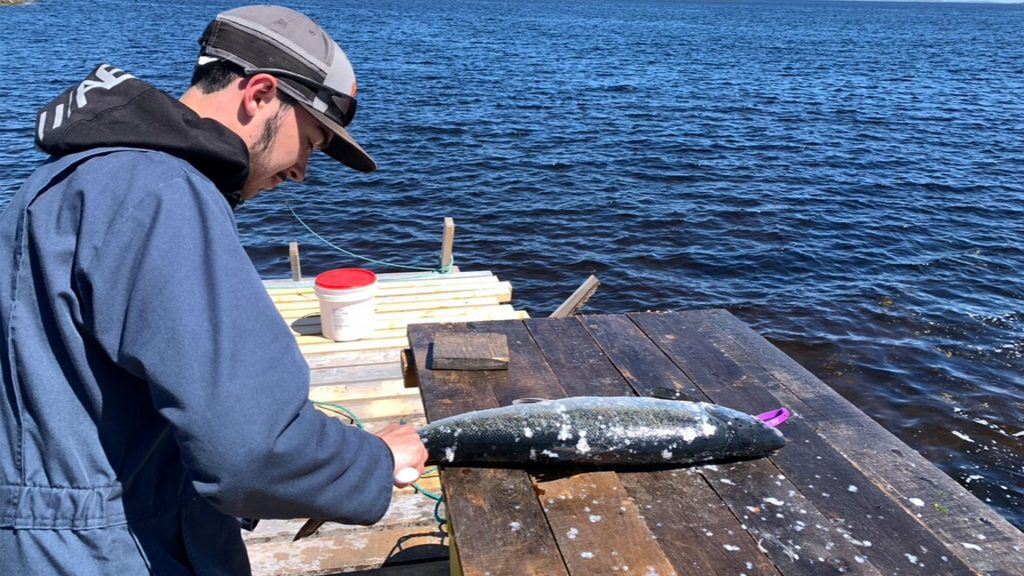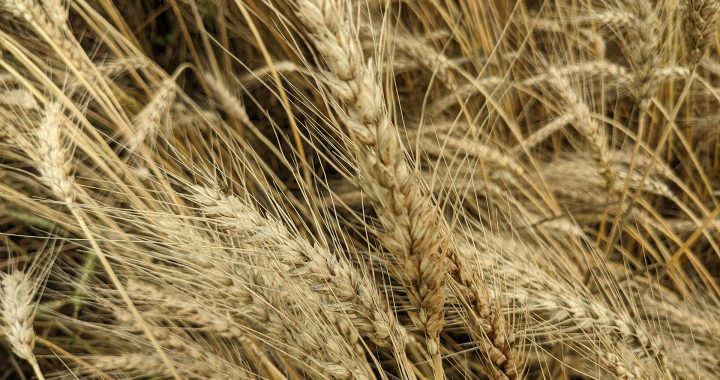
Marcus Ward, a participant in the NunatuKavut Youth Community Engagement Project, cleans a freshly caught salmon in Cartwright, NunatuKavut. Photo: NunatuKavut Community Council.
Rising water temperatures due to climate change is changing the make up of fish stocks off the east coast of Canada and affecting both commercial and ceremonial fisheries.
In Labrador, the NunatuKavut Community Council (NCC) is calling for the full closure of rivers and an immediate stop of catch-and-release fishing until water levels reach a safe and sustainable range to protect migrating salmon heading into the spawning season.
“NCC staff have been extensively monitoring the water temperatures in our rivers based on science and traditional Inuit knowledge and the high temperatures being reported are alarming,” reads a statement by NunatuKavut President Todd Russell and Natural Resources Director George Russell Jr.
The representative council for Inuit communities in Labrador says that catch-and-release fishing — a recreational sport where fish are put back into the water after they’re caught, is too high of a risk amidst rising river temperatures and lower water levels.
The council says that rising water temperatures are alarming to community members and a disruptive impact of climate change.
“We are concerned about climate change and what it is going to mean for the salmon stocks and these rivers,” says George Russell Jr., NunatuKavut’s Environmental and Natural Resources director.
“Hopefully this is just a one off this year and things go back to normal next year, that’s the best we can hope for but there are signs that things are warming up.”
In the last few years, the Atlantic salmon populations have undergone stress due to the hotter and drier summers, says a Government of Canada report on Climate Change in the Atlantic Provinces.
“The once-thriving sports tourism industry created by salmon angling has diminished to the point that sports anglers must now release the salmon alive,” reads the report.
NCC has serious concerns about the health of salmon stocks due to very high water temperatures and calls on @FishOceansCAN for full closure of salmon rivers in NunatuKavut. Read more here: https://t.co/XLNCkOoNQ1
— NunatuKavut (@NunatuKavut) July 21, 2023
Maxime Geoffroy, a research scientist at the Marine Institute of Memorial University of Newfoundland, says the rise of climate change presents unpredictability in the salmon habitats and populations when return to the rivers to spawn.
“We know that with climate change there is more variability from one year to the other, this season there are heat waves in places that are usually cooler and drier areas where you normally have more water during the summer, says Geoffroy.
“The salmon stock are not doing good.”
In late July, the Department of Fisheries and Oceans (DFO) announced a partial closure of salmon rivers in NunatuKavut because of high water temperatures. The partial closure allows recreational anglers to catch and release Atlantic salmon only in the mornings, starting one hour before sunrise until 10:00 am each day.
These measures do not go far enough to protect salmon from unnecessary stress and puts stocks at a higher risk of mortality., says Russell Jr. He says the council wants to see the DFO implement a full closure of the rivers to help salmon during their sensitive migratory period as they travel into spawning season.

“We’re concerned that this activity, with high temperatures, is going to cause unnecessary mortality on these fish in southern Labrador,” says Russell Jr.
“The water levels are lower in a lot of areas and the temperatures are much higher than what we’ve seen in the past.”
NunatuKavut has provided data to the DFO that shows nearly 100 per cent of the salmon harvested by community for their food, social, and ceremonial fishery originates from the rivers the department partially closed.
Closing the rivers would allow the salmon to travel into their breeding grounds without human disruption, leaving an impact on recreational sports anglers but protecting NunatuKavut’s harvest — a vital source of food for community members.
Any impact on the Atlantic salmon populations will be an impact of the people of the NunatuKavut Inuit community says Russell Jr.
“Wild Atlantic salmon is a part of who we are as people and why our communities are even in some of these locations. If they aren’t there anymore, it’s much more than the loss of recreation or food.”
The DFO didn’t respond for comment by publication.
Warmer temperatures not only impacting salmon populations
The increasingly warm temperatures are not only impacting Atlantic salmon populations, they’re also causing a shift in the distribution of Atlantic lobster.
Due to rising ocean temperatures, Atlantic lobster populations, typically found in the coastal waters of Maine – are now migrating north to colder waters and are distributed in higher abundance in eastern Canada.
“Part of the population from Maine now is more in Nova Scotia and New Brunswick, and we see the north limit of the stock off the coast of Newfoundland,” explains Geoffroy.
“We start having more and more abundance and we can forecast that in the coming year that will continue to increase the fishery that exists there.”
Key indicators of climate change on fish stocks and marine ecosystems include rising sea levels, increased ocean temperatures, hypoxia (lack of oxygen), and acidification as outlined in the government of Canada report on Climate Change in the Atlantic provinces.
Along with rising temperatures, the acidification of Atlantic waters is increasing at a higher rate than other parts of the world says the Oceans Now report, indicating additional stress on lobster populations.
Read More:
Mi’kmaw nation, lobster harvesters suing feds for treaty violations
Large amounts of man-made carbon dioxide are dissolving in surface water to form carbonic acid, making waters corrosive to calcium carbonate – the key element lobsters and other crustaceans need to create their protective shells.
“The fact that lobster themselves are changing in ratio, changes what is available for prey and competitors for the fish there and is an indication that the ecosystem as a whole is shifting,” says Geoffroy.
“If you have lobster that are shifting, you have other species also that are changing their distribution as well.”
The movement of lobster populations to the north can be a positive for the Atlantic commercial fisheries says Geoffroy.
However, this migration leaves uncertainty over the balance of the ocean ecosystem, including whether lobsters will migrate further north and put Atlantic fisheries at risk and how other species that rely on lobster as prey will be affected.
“We see that with the climate changing in the season, there are heat waves and floods and unpredictability in the climate is increasing,” says Geoffroy.
“Now you have relatively quick changes in the distribution of a given species which normally would have taken decades to centuries to change.”










